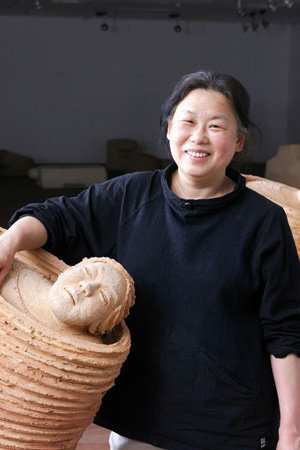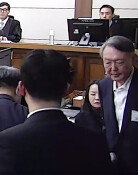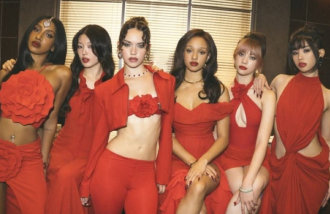Earths Silent Cry toward Humanity
Earths Silent Cry toward Humanity
Posted May. 31, 2005 06:49,

Han Ae-kyu (52), who is mostly doing terracotta work, currently stands unchallenged in the Korean art world.
Terracotta is an Italian word for baked earth, and is a work of baking clay that hasnt been glazed in pot. As the work is time-consuming and slow, with a constant struggle against fatal factors, such as fire, water, sunlight, and moisture, the skill of a master is important. In general, clay is baked at 1,180 degrees for three days, but it could display unintended colors or some chasms on its surface with unskilled handling of the gas fire used to heat it.
Its somewhat hard work for female artists to carry out. However, the work by Han, who does clay work, unlike other female artists, is considered as one of the best works in the world of artists.
Her workroom occupies around 40-pyeong of basement space under her house in Samsong-dong, Goyang City, Gyeonggi Province, and looks like a construction site. In one corner of a room, where heaps of earth and various kinds of tools were scattered everywhere, clay works, which were extensions of her persona, were waiting to go into the fire.
Han, who says that she commutes everyday from the first-floor to basement with rough hands and wearing dirty sneakers caked with soil, no make-up, and binding her hair into a basic hairstyle, laughed saying that her mother, who recommended becoming an artist to her daughter who wanted to be a reporter, now reached a point where she says that had she known her job was this difficult, she wouldnt have allowed her daughter to become an artist.
Hans trade mark is a plump middle-aged woman with gentle brown colored round cheeks and thick lips.
So far, Han has expressed subjects ranging from household duties, child rearing, womens restraint and liberation while being fettered by social structure, and motherhood energy, a source of nature and life.
In her early days of working, many of her female sculptures bore the expressions of anger, renunciation, agony, and despair, but as time went by, those expressions have changed into happiness, expectation, hope, and further, generosity and serenity, like those of Buddha.
Even so, the works to be displayed at Hans one-woman show titled Silence, which will be held on the third-floor of the Insa Art Center in Gwanhun-dong, Jongno-gu, Seoul, on June 1, have drastically changed to make people wonder whether they were really her works.
With no female sculptures in sight, around 30 works that were expressed in the form of massive stones while featuring the simplified forms of humans and animals will be put on view.
The exhibition room looks as if it contained a pile of huge stones or ruined remains. Visitors can lean against or sit on them and take a rest on the works, while walking around the works as if they were moving around an ancient city.
It seems that people could recover from emotional scars while lying down on a soft work of art and resting in silence.
Han noted, I traveled around European countries during several years and saw collapsed pillars and streets that people might have walked on countless times, and corners on which someone might have terribly waited for somebody else. I thought of the history made by those people, who might have had their own splendid times. In this work, I expressed the thought of being silent while bearing many stories that have been accumulated over the course of time.
Like Hans saying that she hasnt dealt with the subject of woman out of awareness of purpose but that she has merely handled the story about women because she is a woman, this exhibition shows the concept for her work is now going beyond women, into humanity itself, and the source of life. In addition, a total of 30 relief works named the dream sequence, based on dreams will be displayed as well. The exhibition will continue until June 13. For more information, call 02-736-1020.
Mun-Myung Huh angelhuh@donga.com






![“설거지해도 그대로”…냄비 ‘무지개 얼룩’ 5분 해결법 [알쓸톡]](https://dimg.donga.com/c/138/175/90/1/wps/NEWS/IMAGE/2026/01/15/133164664.3.png)
